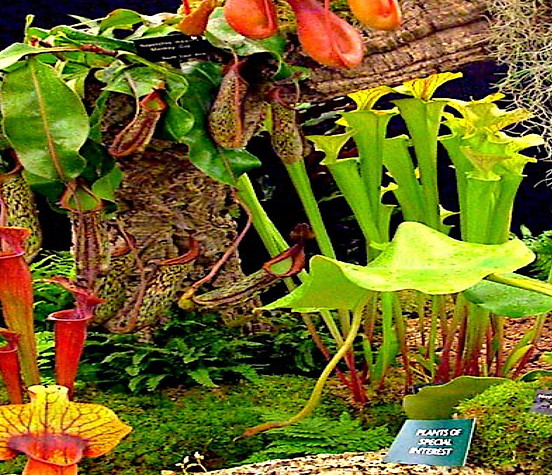Our Plants
of Interior
SUCCULENTS
Succulent plants are those that have a thickened root, stem or leaves to allow the storage of water in much larger quantities than in normal plants. This adaptation allows them to maintain liquid reserves for prolonged periods, and to survive in arid and dry environments that would be uninhabitable for other plants.
The most typical example of succulence is that of cacti, whose stalks have a thick layer of parenchymal tissue. In addition to cacti, other plant families exhibit the same phenomena.
The adaptation of succulents allows them to colonize sparsely populated environments, which receive little competition from other species and where herbivores are scarce. To make it possible to capture the scarce humidity present in the environment, many succulents are pubescent, that is, they have a surface covered with hairs that retain the morning dew.
BONSAI
Bonsai (Japanese: 盆栽, bon-sai) means "cultivated, planted in a tray or pot". Contrary to what many people think, the ideogram does not contain the word tree 木 (Ki).
A bonsai needs to have other attributes besides simply being planted in a small, shallow pot. The plant must be a miniature replica of a tree from nature. It should simulate growth patterns and the effects of gravity on the branches, as well as time stamps and general structure of the branches. Essentially it is a work of art produced by man through specialized care.
Bonsai is not a specific plant species, but a technique used on trees with the aim of “miniaturizing” them, taking inspiration from existing forms in nature. There is no Bonsai tree, but trees that are transformed by the Bonsai process. In practice, it is the art of selecting and transforming trees that have the potential to resemble a replica in nature.
ORCHIDS
Orchids are all plants that make up the Orchidaceae family, belonging to the order Asparagales, one of the largest families of existing plants. They have many and varied shapes, colors and sizes and exist on all continents, except Antarctica, predominating in tropical areas. They are not parasitic plants, feeding only on decomposing material that falls from trees and accumulates by becoming entangled in their roots. They find many forms of reproduction: in nature, mainly by dispersing seeds, but in cultivation by dividing clumps, in-vitro sowing or meristemage.
Regarding the enormous variety of species, there are very few cases in which commercial uses for orchids have been found beyond ornamental use.
Among its few uses, the only widespread one is the production of vanilla from the fruits of some species of the genus Vanilla, but even this is limited by the production of a similar artificial compound at a much lower cost. Even for ornamentation, only a small portion of the species is used, as the vast majority have small flowers and unattractive foliage. On the other hand, from the showy species, orchid growers have been obtaining thousands of different hybrids with great effect and commercial appeal.
AIR PLANT
Tillandsia, also known as air plants, are able to extract moisture and nutrients from the air, which they need to live. These plants are found in nature, in the forests, deserts and mountains of Central and South America, Mexico and the southern United States. Most Tillandsia have no or almost no roots and grow on trees or rocks. One of the best known species of Tillandsia is the usneoides or Spanish moss.
FLORIDA
Flowering indoor plants are plants that are distinguished by the exuberance of their flowering and that allow you to flood your interior space with joy.
GREENS
Green plants are those that stand out for their foliage and that, although they can flower, are not very significant from an aesthetic point of view.
They are particularly suitable for places with less intense lighting
VERDES
FLORIDAS
CARNIVERES
Carnivorous plants or insectivorous plants are plants that have the ability to attract small animals, including insects (main prey), arachnids and even amphibians, reptiles and birds, capture (through traps composed of modified leaves), digest (through digestive enzymes ) and utilize nutrients (mainly nitrogenous compounds) from their prey. They generally live in poor soils, soaked in acids (low pH) with little availability of nitrates (essential for the synthesis of the chlorophyll molecule), thus depending on the nitrogen contained in the animal proteins, but, like all plants, it is dependent on the energy that comes from it. light to survive.
Carnivorous plants occur predominantly in the tropical zone of the planet, with great biodiversity in Southeast Asia, the Americas and Australia. A smaller number of species occur in southern Europe and Africa, and the best adapted to their habitat of occurrence are found in inhospitable places such as Alaska, Scandinavia and the Australian desert.
BROMELIAS
Bromeliad is available in 2800 different species, originating from the rainforests of South and Central America. The first Bromeliads originated about 65 million years ago, a real cousin plant! They have hardly changed in all these years!
There are bromeliads that grow on the ground (terrestrial) and bromeliads that grow on trees (epiphytes) to get more light.
Epiphytic bromeliads do not have a negative effect on these trees because they, with their roots and leaves, extract moisture and food from the air (and not from the tree).
The central calyx has fine hairs and scales to absorb water.
The bromeliad in nature in its calyx also accumulates old rotten leaves and bird droppings, feeding on it.







